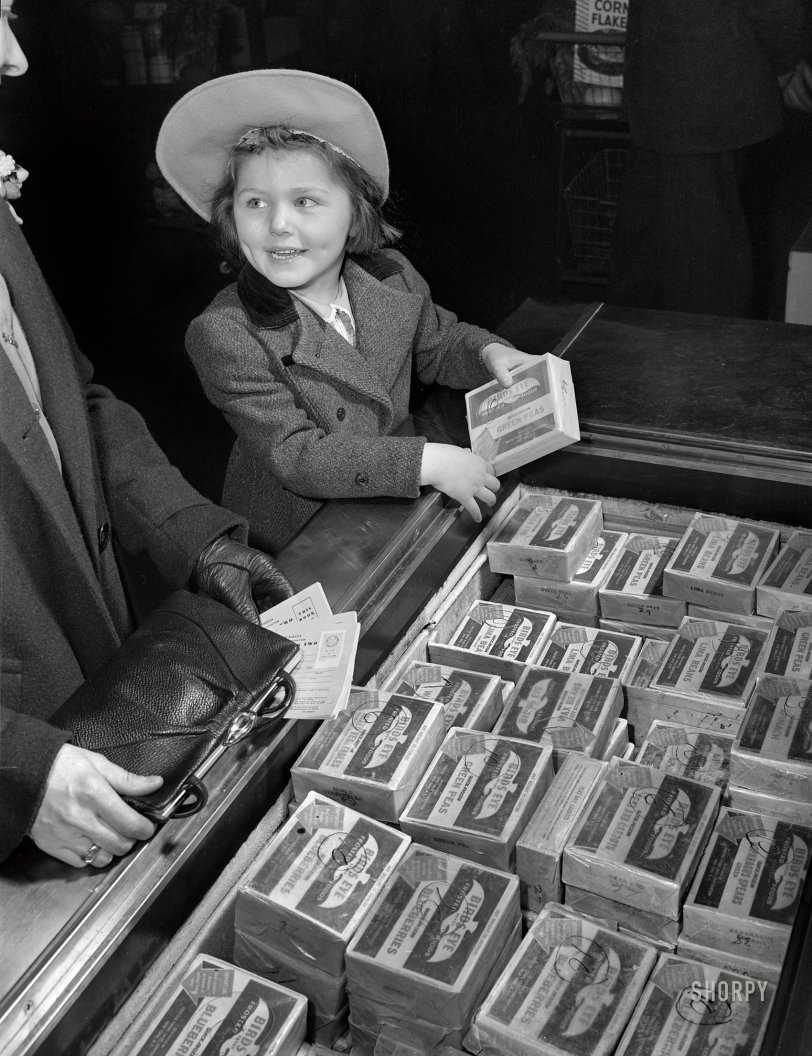


Framed or unframed, desk size to sofa size, printed by us in Arizona and Alabama since 2007. Explore now.
Shorpy is funded by you. Patreon contributors get an ad-free experience.
Learn more.

- Lofty addition
- In 1912
- Keenan Building
- Six years old
- Taken from the P.J. McArdle Roadway?
- It stood only 47 years
- Three track mind
- Incline to the right
- Reach for the sky, 1912 style
- No clean sweep
- Same Job Title, Same Face
- Sadly Lost
- Beautiful ...
- Where you get your kicks
- Aim High
- Pueblo Revival sisters
- Pueblo Neoclassicism
- Milk Man
- Regional dialect.
- Spielberg's inspiration
- Great Photo
- Loaf Story
- Do you still have the Rakes category?
- Could almost be a scene from the 1957 movie 'Hell Drivers'
- The Wages of Fear.
- Conspicuous by their absence
- Got Milk?
- All that aluminum
- No lefties
- Smoke 'em if you've got 'em
Print Emporium
Frozen: 1943

February 1943. Washington, D.C. "Preparation for point rationing. While Mother keeps handy her War Ration Book Two, daughter examines the frozen foods which require removal of point stamps." 4x5 acetate negative by Alfred Palmer, Office of War Information. View full size.
The revolutionary Clarence Birdseye
As a fan of Mark Kurlansky's writings, I recommend his book "Birdseye: The Adventures of a Curious Man." From the jacket:
While working as a fur trapper in Labrador, Canada, Clarence Birdseye encountered an age-old problem: bad food and an unappealing, unhealthy diet. However, he observed that fresh vegetables wetted and left outside in the Arctic winds froze in a way that maintained their integrity after thawing. As a result, he developed his patented Birdseye freezing process and started the company that still bears his name. Birdseye forever changed the way we preserve, store, and distribute food, and the way we eat.
Keeping frozen food
When I was kid (around 1953) we had one of those refrigerators with a tiny freezer compartment. My mother generally had a couple of boxes of frozen veggies in there, which was all that would fit. The winter fresh vegetable selection on the east coast was pretty thin, and expensive, so we had frozen and canned. It wasn't until around 1960 that we got a separate freezer in the garage.
Vegetables for 13, Please Alex
What is the 13-pointer in the freezer corner, right under the young lady's hand? It's the most expensive item in the freezer. It looks like it starts with "AN", but an internet search doesn't turnip (pun intended) any vegetables starting with "An". Could be rhubarb if that's not an "AN". Would rhubarb command a ration points premium of 13?
[It is indeed rhubarb. - Dave]
Crooner Bing Crosby
had a lot to do with the frozen food industry back then, especially with frozen orange juice.
Grandmother's Chest
Frozen food became considerably more common after WWII, when home freezers were again available. My grandmother bought one in 1946 and how well I remember those delightful frozen peas and corn, unlike those mushy canned offerings. And having fudgesicles at home--heavenly. When she died my wife and I inherited the chest-type freezer, and used it for nearly forty more years. In all, it lasted more than fifty. They don't make 'em like that now.
Frozen = leftovers
We used to buy frozen veggies and cook them the same day, then we would refrigerate the leftovers. They were good for a few more days when refrigerated. Did the same with frozen fruit too. We had an ice box, then a fridge with the minuscule freezer, not room to keep much of anything frozen. We never had ice cream in the freezer, that's what made going to town for ice cream so special. I still take the wife out for an ice cream on occasion.
As a small child
I remember those frozen vegetable packages. The wrapper was a heavy waxed paper. No plastic back then.
Egg before chicken
Slightly over half of Americans owned refrigerators before the war, and freezer sections were just large enough for two ice cube trays, and little more. You couldn't buy a new fridge during the war, or for a couple of years after that, either.
[On the other hand, the stores wouldn't be selling all this frozen food if people didn't have a place to keep it. - Dave]
























On Shorpy:
Today’s Top 5